Basketball Pre-game Warm-up Drills
From the Coach’s Clipboard Basketball Playbook"Helping coaches coach better..."
Disclosure: This page contains affiliate links, which means that Coach's Clipboard receives a small commission (at no cost to you) if you make a purchase using these links.
Coaches are often looking for good pre-game warm-up drills. You could use almost any of your favorite drills that get players moving, hustling and sweating a little. If your team habitually gets off to a slow start in the first few minutes, review your pre-game drills and make sure players are not loafing. Warm-ups are for getting ready to play. This page presents several drills.
In addition, make sure to get in some free-lance shooting with players shooting the shots they are likely to get in the game. If time permits, shoot team free throws.
While you are on the sideline visiting with opposing coaches and the officials, checking your line-up and the scorebook, involve your assistants in these warm-ups, making sure there is energy and hustle.
Before Taking the Court - Warm-up Exercises, Stretching, etc.
You can get players loose, limber by doing these warm-up/training drills from Alan Stein in the locker-room, a classroom, or a hallway before taking the court.Lay-up Drills
Choose one of these lay-up drills.Classic 2-Line Layup Drill
This drill has been around since basketball was invented, and is still a good warm-up drill. See the diagram. There are two lines, a "shooting" line and a "rebounding" line.The drill starts with the first shooter dribbling in and shooting the lay-up, while the first rebounder rebounds and passes to the next shooter cutting toward the basket. The shooter goes to the rebounding line and the rebounder goes to the shooting line. After a couple minutes, switch sides so that now the left line is the shooting line (for shooting left-handed lay-ups). As an option, run the drill with two balls. In addition to standard right and left-handed lay-ups, also get some reps on both sides doing reverse lay-ups and inside-hand lay-ups.
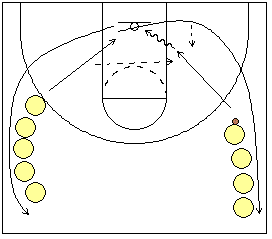
Pointers:
- Dribble with the left hand for left-handed lay-ups, and the right hand for right-handed lay-ups.
- Passes should be bounce passes.
- Make sure the two lines start well outside of the arc. If the lines are too close to the basket, there is little running and the drill tends to drag. Run this drill at game speed.
3-Line Layup Drill
A few players line up at the top of the key, one player in the right corner, and the rest of the players line up at half-court near the right sideline. Use two balls as seen in the diagram.Player #1 passes to player #2 and makes a sharp basket-cut. Player #2 bounce-passes back to #1 who shoots a lay-up (see diagram A). After shooting, #1 goes to the top-of-the-key line.
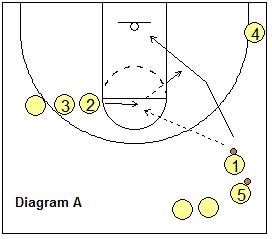
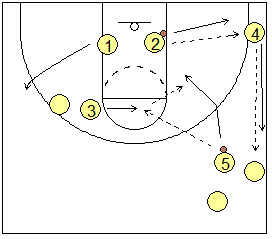
Player #2 rebounds and passes to player #4 in the corner. Player #2 follows the pass and goes to the corner. Player #4 passes to the next player in line, follows the pass, and goes to the end of half-court line. Run this drill for both right and left handed lay-ups.
Vanderveer 3-Line Backdoor Layup Drill
This drill is used by Hall of Fame Coach Tara Vanderveer (Stanford). It features good passing, lay-ups and passing to a wing back-cutter. It reinforces the "dribble-at, back-cut" rule used in many offenses.Use three lines (diagram 1) and a rebounder under the basket. O3 passes to O1. O1 takes a dribble or two toward O2. O2 back-cuts and gets the pass from O1, and finishes the lay-up. O4 rebounds and passes to the next O3 in line. The pass to the back-cutter should be a good bounce pass, right up the lane line. Use three balls and go quickly. Players rotate over to the next line (O3 to O1, O1 to O2, O2 to O4, O4 to O3).
After one time through (bounce passes to the cutter), have players make an air pass to the back-cutter the second time through. You can add token defense with an assistant loosely guarding each passer, and a third assistant with a foot above the arc denying the pass to O2, who then back-cuts. Make sure the O3 passers are making good outside-hand air passes to O1.
Lastly, reverse the drill and do left-handed lay-ups (diagram 2). O2 passes to O1, and O3 is the back-cutter.
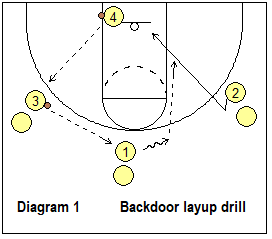
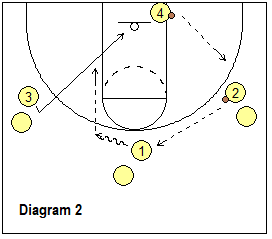
Close-Outs, Defense Drills
Select a good, quick close-out drill. For man-to-man defense (on-ball, deny, helpside, etc) we have also used the 4-on-4-on-4 live shell drill.Simple Close-Out Drill
See the diagram below. Players pair up; players on the baseline each have a ball, and roll it out to his/her partner. He/she then closes-out on the ball, yelling "Ball! Ball! Ball!". Switch it around, each player getting two or three reps.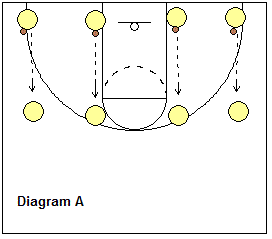
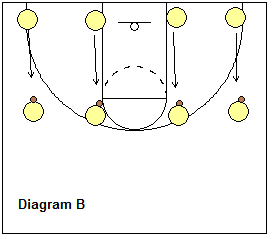
Arico Close-Out Drill
This intense close-out drill is from Kim Barnes Arico, head women's coach at University of Michigan. The drill features three close-outs and then live 3-on-3. Diagram A below shows three offensive players, O1, O2 and O3 at the point and both wings. Three defenders start under the basket.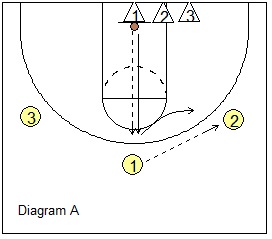
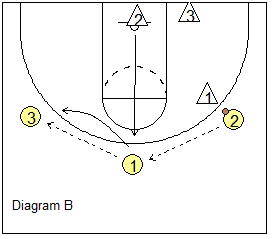
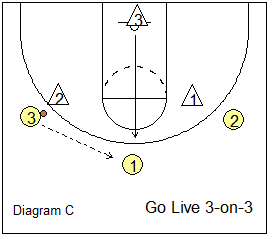
The first defender X1 rolls the ball out to O1 and sprints out and closes-out on the ball. O1 then passes to O2, and for the purpose of this drill, X1 jumps to the ball and closes-out on O2. O2 passes back to O1 (diagram B) and the next defender (under the basket) X2 sprints out and closes-out on the ball.
O1 then passes to O3, and X2 jumps to the ball and closes-out on O3. O3 passes back to O1 (diagram C). The third defender X3 sprints out and closes-out on O1, and now we go live 3-on-3 until either a score or a defensive stop.
To make it competitive, split your team in half. Yellow team starts on offense, white on defense. Substitute players with each possession so they all get in.
All defensive players are along the baseline and all offensive players come in from the top. Keep score for each possession. Each team gets five to seven possessions (depending on how much time you have), and then we switch offense and defense. Losers either run or do pushups.
Also see this footwork (with close-outs) drill.
Shooting Drills
Here are a couple shooting drills.Cutter Shooting Drill
See the diagrams below. Players are on the wings. O1 (left wing) cuts into the key and gets the pass from O2 (right wing) and shoots the jump-shot at the free-throw line/elbow area. The shooter O1 gets his/her own rebound and passes to the opposite line and follows the pass to that line. Meanwhile, after passing, O2 then cuts into the key and gets the pass from O3 on the left wing. O2 shoots, rebounds and moves to the left line. And so the sequence goes until everyone has gotten a few shots.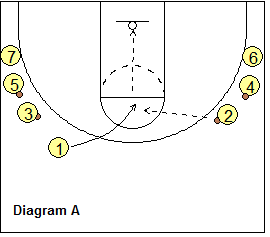
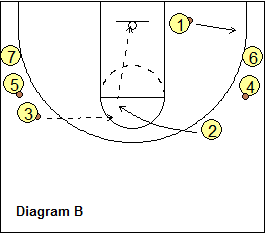
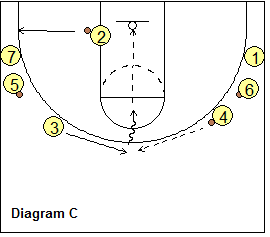
Next, the cutter cuts to the top 3-point arc for the pass (diagram C), catching and facing the basket in triple-threat position. He/she makes a good shot fake, followed by a one-dribble jump-shot. After everyone has had a few reps, we will have the shooter catch and shoot the 3-point shot.
Finish the drill by allowing players to free-lance, choosing to (1) shoot the 3-pointer, or (2) shot-fake and one-dribble jump-shot, or (3) shot-fake and dribble-drive to the hoop.
Stress that this is not only a shooting drill, but a passing drill. Demand good, crisp accurate passes. The pass must not be made too early (across court). The cutter should receive the pass near the middle of the key, while moving toward the ball. Make sure players are at game-speed making good hard cuts.
Endline Cutter Shooting Drill
Players are on the endline in two lines (at the lane lines). Start the drill with shots close to the basket, and then after each player has had a few shots, move out a little to the elbows (diagram D), and then eventually out to the 3-point arc (diagram F).Diagram A shows O1 cutting across the lane for the pass from O2 and the pull-up jump-shot. After passing, O2 cuts around, outside the shooter O1, cuts to the left side for the pass from O3 (diagram B). O3 then cuts around to the right side for the pass from O4 (diagram C), and so it goes. Shooters get their own rebound and go to the end of the opposite line.
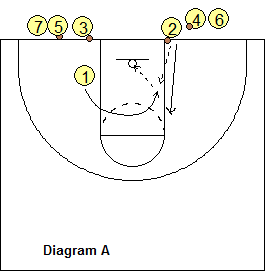
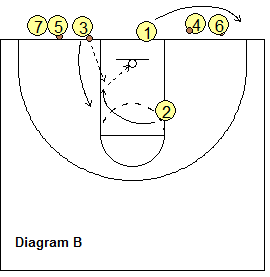
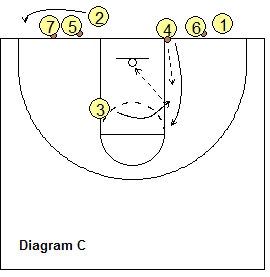
Cuts and passes should be at game speed. Cutters should call for the ball "Ball!" and have both hands up giving the passer a good target. Shooters should catch the ball squared up to the basket ready to shoot with a good quick release. There is no dribbling in this drill - just cutting, passing and catching, and shooting.
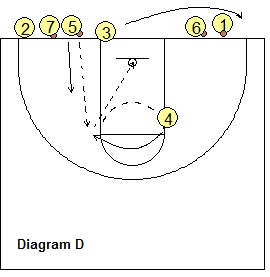
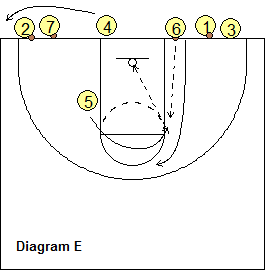
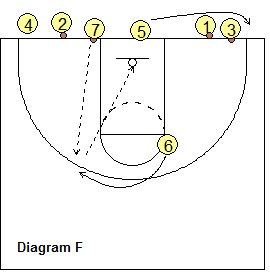
Open Free-Lance Shooting and Free-Throws
Allow some time for open shooting with players taking shots they are likely to get in the game. Finally, shoot some free-throws.7-Man Half Court Drills or 3-on-2 Drill
Players will be going 3-on-2. You can either start this with three lines near half-court (straight 3-on-2), or you can start on the baseline with just one player in the middle, and two lines on opposite sides - the diagram shows the later.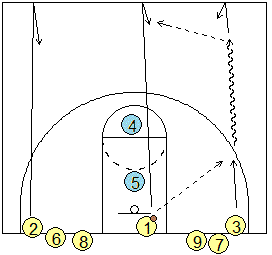
Defenders 4 and 5 are in a stacked position. 1 outlet passes to 3 (or 2). All three offensive players sprint or speed dribble to the half-court line, touch the line and then turn around and go 3-on-2 vs the two defensive players.
The same rules apply as in the full-court drill above, except that the player who gets the rebound or steal, instead of making the outlet to the side, runs quickly out-of-bounds in the center under the basket (where 1 started initially) and then passes inbounds to either of the next two players in line (either 6 or 7).
Again, the four who did not get the rebound immediately yell "defense". The first two to yell it become the next two defenders on that end and the other two go to the ends of the two lines on opposite sides.